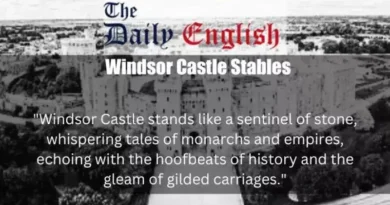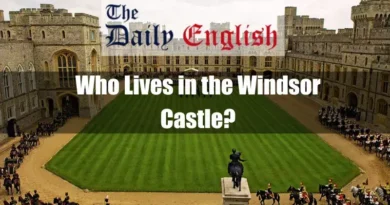Buckingham Palace vs Windsor Castle
Windsor Castle and Buckingham Palace are two of the most iconic royal residences in the United Kingdom, each with unique characteristics. Windsor Castle, located in Berkshire, is the world’s oldest and largest inhabited castle, with a history spanning nearly 1,000 years. It encompasses over 1,000 rooms and 300 fireplaces, covering approximately 484,000 square feet across 13 acres.
In contrast, Buckingham Palace, situated in the heart of London, serves as the British monarch’s official residence and administrative headquarters. Constructed in the 18th and 19th centuries, it boasts 775 rooms, including 19 state rooms, 52 royal and guest bedrooms, 188 staff bedrooms, 92 offices, and 78 bathrooms, spanning about 828,818 square feet over 39 acres.
While Buckingham Palace is renowned for hosting state occasions and events like the Changing of the Guard, Windsor Castle offers visitors attractions such as the State Apartments, St. George’s Chapel—housing the tombs of eleven monarchs, including Queen Elizabeth II—and Queen Mary’s Dolls’ House.
Notably, Buckingham Palace is undergoing a significant £369 million refurbishment, leading to a suspension of state visits there until 2027, with such events being relocated to Windsor Castle during this period.
Comparison Between Buckingham Palace and Windsor Castle
| Category | Buckingham Palace | Windsor Castle |
|---|---|---|
| Historical Background | Built in 1703 as a townhouse, became a royal residence in 1761, and an official palace in the 19th century. | Founded in the 11th century by William the Conqueror as a defensive stronghold, later transformed into a royal residence. |
| Evolution of Role | Became the monarch’s official London residence in 1837 under Queen Victoria. | Adapted over centuries, serving as a military stronghold, state residence, and ceremonial venue. |
| Architectural Style | Predominantly neoclassical with grand facades and symmetrical designs. | A mix of Norman, Gothic, Baroque, and Victorian architectural styles. |
| Major Expansions | Significant additions in the 19th century under King George IV and Queen Victoria. | Expanded multiple times, with major works by Edward III, Charles II, and George IV; restored after the 1992 fire. |
| Notable Features | The central balcony, used for royal appearances; the Grand Staircase; 775 rooms, including state rooms. | The Round Tower, St George’s Chapel, State Apartments, and extensive grounds. |
| Current Role | The monarch’s official London residence and administrative headquarters. | A royal residence used for official and private events, particularly at weekends and during Easter. |
| Official Events | Hosts state banquets, receptions, investitures, and garden parties. | Hosts state visits, royal weddings, and ceremonies in St George’s Chapel. |
| Residential Use | Contains private apartments for the monarch and royal family members. | A preferred retreat for the monarch and frequently used for private stays. |
| Location | Westminster, central London, surrounded by royal parks. | Windsor, Berkshire, about 25 miles west of London, overlooking the River Thames. |
| Accessibility | Open to the public in summer; well-connected by underground and bus routes. | Open year-round except for official events; accessible by train and road. |
| Visitor Experience | Tours include the State Rooms and gardens; the Changing of the Guard is a major attraction. | Visitors can explore State Apartments, St George’s Chapel, and Queen Mary’s Dolls’ House. |
| Cultural & Historical Significance | A symbol of national resilience during WWII; central to royal celebrations and televised events. | A refuge during wartime; the site of many royal weddings, funerals, and historical events. |
| Representation in Media | Featured in documentaries, films, and TV series such as The Crown. | Prominently featured in royal documentaries and historical dramas. |
| Recent Developments | Undergoing a £369 million refurbishment (2017–2027) to modernise infrastructure. | Restored after the 1992 fire; ongoing maintenance and conservation efforts. |
| Public Engagement | State Rooms opened to the public since 1993; generates revenue for maintenance. | Public access has expanded over time, enhancing appreciation of royal history. |
| Unique Attributes | The primary residence of the monarch in London, synonymous with state affairs and national celebrations. | The oldest and largest inhabited castle in the world, serving as a royal retreat and ceremonial site. |
Introduction
Windsor Castle and Buckingham Palace are two of the most renowned royal residences in the United Kingdom, each serving as significant symbols of the British monarchy. Windsor Castle, located in Berkshire, is the world’s oldest and largest inhabited castle, with a history spanning over nine centuries. Buckingham Palace, situated in the heart of London, serves as the official administrative headquarters of the British monarch. Both palaces have played pivotal roles in the nation’s history, evolving through the centuries to accommodate the changing needs of the monarchy and the state.
Historical Background
Origins and Early History of Windsor Castle
Windsor Castle’s origins date back to the 11th century, following the Norman invasion of England. William the Conqueror selected the site for its strategic position overlooking the River Thames and its proximity to London. Initially constructed as a motte-and-bailey castle, it was intended to secure Norman dominance over the surrounding area. Over the centuries, the castle underwent numerous expansions and renovations, transforming it into a grand royal residence. Notably, during the reign of Edward III in the 14th century, Windsor Castle became the centrepiece for the newly established Order of the Garter, reflecting its growing significance in royal ceremonial life.
Origins and Early History of Buckingham Palace
Buckingham Palace’s origins are comparatively more recent. The core of the palace was originally a large townhouse built in 1703 for the Duke of Buckingham. In 1761, King George III acquired the property as a private residence for Queen Charlotte, and it became known as the Queen’s House. Significant expansions occurred in the 19th century, particularly under King George IV, who commissioned the architect John Nash to transform the house into a palace. Nash’s work included the addition of new wings and refacing the exterior in Bath stone, establishing Buckingham Palace as a symbol of the British monarchy.
Evolution of Their Roles Over the Centuries
Windsor Castle has continuously adapted to the needs of successive monarchs. During the English Civil War in the 17th century, it served as a military headquarters. In the Restoration period, King Charles II renovated the castle, introducing Baroque interiors to rival the splendour of European courts. In the 19th century, King George IV and Queen Victoria further enhanced its status as a royal residence, with Victoria making it her principal home, thereby solidifying its role in state affairs and royal ceremonies.
Buckingham Palace’s evolution into the monarch’s official London residence occurred in the 19th century. Queen Victoria was the first sovereign to reside there in 1837, marking a shift in its status from a private residence to the administrative heart of the monarchy. Since then, it has hosted numerous state occasions, including banquets, receptions, and the annual Trooping the Colour ceremony, reinforcing its role as a focal point of national life.
Architectural Overview
Architectural Styles and Influences
Windsor Castle showcases a blend of architectural styles, reflecting its long history. The original Norman motte-and-bailey structure has been transformed through Gothic, Georgian, and Victorian influences. The castle’s Gothic architecture is particularly evident in St George’s Chapel, a masterpiece of Perpendicular Gothic design. The State Apartments, redesigned in the 17th and 19th centuries, exhibit Baroque and Rococo elements, highlighting the castle’s evolution through various architectural trends.

Buckingham Palace’s architecture is predominantly neoclassical. John Nash’s 19th-century design introduced grand facades and interiors inspired by classical antiquity, characterised by symmetry, columns, and elaborate decorative motifs. The East Front, added later, features the famous balcony from which the royal family greets the public. The palace’s architectural coherence has been maintained through subsequent renovations, preserving its neoclassical elegance.
Major Renovations and Expansions
Windsor Castle has undergone several significant renovations. King Charles II’s 17th-century refurbishment introduced luxurious Baroque interiors. In the 19th century, King George IV commissioned architect Jeffry Wyatville to modernise the castle, including raising the Round Tower’s height and redesigning the State Apartments. The 1992 fire led to a major restoration project, which meticulously restored the damaged sections to their former glory.
Buckingham Palace’s major expansions occurred primarily in the 19th century. John Nash’s work for King George IV included new wings and state rooms. In the 1840s, Queen Victoria and Prince Albert added the East Front, creating a quadrangle and providing more space for the growing royal family and official functions. The palace has also seen modern updates, such as installing electricity and refurbishing certain areas to accommodate contemporary requirements.

Notable Architectural Features
Windsor Castle’s notable features include the Round Tower, which serves as a prominent symbol of the castle, and St George’s Chapel, renowned for its intricate stonework and as the spiritual home of the Order of the Garter. The State Apartments are adorned with an extensive collection of art and furnishings, reflecting the tastes of successive monarchs.
Buckingham Palace’s iconic features encompass the central balcony on the East Front, used for public appearances by the royal family. The palace boasts 775 rooms, including 19 state rooms used for official engagements. The Grand Staircase, designed by Nash, is a focal point of the interior, showcasing opulent design and serving as a prelude to the richly decorated state rooms.
Both Windsor Castle and Buckingham Palace embody the architectural and historical legacy of the British monarchy, each reflecting the evolving tastes, functions, and statuses of the royal family over the centuries.
Function and Usage
Current Roles within the Monarchy
Buckingham Palace serves as the British monarch’s official London residence and administrative headquarters. It is the central venue for state occasions, and official entertaining and is the primary workplace for the monarchy, housing the offices of the royal household. Windsor Castle, located in Berkshire, functions as both a private residence and a royal palace, often used by the monarch for weekends and official events. It is also a significant ceremonial location, hosting state visits and royal weddings.
Official Events and Ceremonies Hosted
Buckingham Palace is the site of numerous official events, including state banquets, receptions, and investitures. State banquets, held in the grand Ballroom, are formal dinners honouring visiting foreign heads of state. Investitures, ceremonies where individuals receive honours, typically occur in the Throne Room. Additionally, the palace hosts garden parties, welcoming thousands of guests each summer. Windsor Castle also hosts significant events, such as state visits, where ceremonial welcomes are conducted in the Quadrangle, and St George’s Chapel within the castle grounds has been the venue for numerous royal weddings and funerals.
Residential Use by the Royal Family
Buckingham Palace contains private apartments for the monarch and other royal family members, serving as their London residence. The monarch frequently uses Windsor Castle as a weekend retreat and during Easter Court, a month-long residence during Easter. Both residences provide private quarters alongside their official staterooms.
Location and Accessibility
Geographical Locations and Surrounding Environments
Buckingham Palace is situated in Westminster, central London, surrounded by the royal parks, including St James’s Park and Green Park. Its urban setting places it at the heart of British political and cultural life. Windsor Castle is located in the town of Windsor, Berkshire, approximately 25 miles west of London, set within extensive parkland and overlooking the River Thames. The castle’s elevated position provides commanding views of the surrounding countryside.
Accessibility to the Public and Transportation Options
Buckingham Palace opens its State Rooms to the public during the summer months, offering tours that include exhibitions and access to the palace gardens. The palace is accessible via several London Underground stations, including Victoria, Green Park, and Hyde Park Corner, as well as numerous bus routes. Windsor Castle is open to visitors year-round, but there are certain restrictions during official events. It is accessible by train from London Paddington to Windsor & Eton Central or from London Waterloo to Windsor & Eton Riverside, as well as by road via the M4 motorway.
Visitor Experience
Tour Options and Visitor Attractions
At Buckingham Palace, visitors can explore the State Rooms during the annual summer opening, view special exhibitions, and enjoy the palace gardens. The Changing of the Guard ceremony, a popular attraction, takes place outside the palace several times a week. Windsor Castle offers State Apartments, St George’s Chapel, and Queen Mary’s Dolls’ House tours. The castle’s long history and active role as a royal residence provide a rich visitor experience.
Highlights of Interior Rooms and Art Collections
Buckingham Palace’s interiors include the Throne Room, which is used for ceremonial receptions; the Picture Gallery, which displays works by renowned artists; and the Ballroom, the largest room in the palace, used for state banquets. Windsor Castle’s highlights include the State Apartments, adorned with masterpieces from the Royal Collection; St George’s Chapel, a stunning example of Gothic architecture and the spiritual home of the Order of the Garter; and the Semi-State Rooms, used by the monarch for private entertaining.
Visitor Facilities and Amenities
Both Buckingham Palace and Windsor Castle provide visitor facilities, including cafés, gift shops, and accessible restrooms. Audio guides are available in multiple languages, offering detailed information about the history and significance of the rooms and artefacts on display. Educational programmes and workshops are also offered, catering to schools and families.
Cultural and Historical Significance
Key Historical Events Associated with Each Residence
Buckingham Palace has been the backdrop for numerous significant events in British history. During World War II, it endured bombing raids, symbolising national resilience. The palace has hosted countless state banquets, receptions, and ceremonies, reinforcing its role as a centrepiece of British ceremonial life. Notably, it has been the focal point for national celebrations, such as jubilees and royal weddings, where crowds gather to witness the royal family on the iconic balcony.
Windsor Castle has similarly played a pivotal role in the nation’s history. It was a refuge for the royal family during wartime and has hosted significant events, including the wedding of Prince Harry and Meghan Markle in 2018. The castle’s St George’s Chapel has been the site of numerous royal ceremonies, including the recent funeral of Prince Philip in 2021.
Cultural Impact and Representation in Media
Both residences have been extensively featured in media and popular culture. Documentaries like “The Queen’s Palaces” delve into their histories and significance. Dramatisations, such as the television series “The Crown,” have depicted events set within their walls, influencing public perception and interest. Their iconic statuses have made them subjects of artistic works, literature, and tourism campaigns, embedding them deeply in the nation’s cultural fabric.
Recent Developments
Recent Renovations and Their Implications
Buckingham Palace is undergoing a ten-year refurbishment programme, initiated in 2017, to update essential services like electrical wiring, plumbing, and heating. The £369 million project aims to preserve the building’s structural integrity and improve energy efficiency. However, public opinion is divided regarding the use of taxpayer funds for this purpose, with some advocating for alternative financing methods.
Windsor Castle has also seen restoration efforts, particularly following the 1992 fire that caused extensive damage. The subsequent restoration, completed in 1997, was funded through a combination of insurance, public contributions, and opening Buckingham Palace to visitors for the first time, setting a precedent for funding royal residence repairs.
Changes in Public Access and Usage
Public access to both residences has evolved over time. Buckingham Palace’s State Rooms have been open to visitors during the summer months since 1993, providing insight into royal life and generating revenue for maintenance. Windsor Castle is open year-round, except during official events, allowing the public to explore its rich history and architecture. These initiatives have increased transparency and public engagement with the monarchy, fostering a greater appreciation of Britain’s cultural heritage.
Comparison Summary
Similarities Between the Two Residences
Both Buckingham Palace and Windsor Castle serve as official residences of the British monarch, hosting state events, ceremonies, and receptions. They are architectural landmarks with rich histories, reflecting the monarchy’s evolution and the nation’s heritage. Both have adapted to modern needs while preserving their historical significance, and they offer public access, enhancing their roles as cultural and tourist attractions.
Distinct Differences and Unique Attributes
Buckingham Palace, located in London, functions as the administrative headquarters of the monarchy and is synonymous with state occasions and official receptions. Its urban setting makes it a focal point for national celebrations. Windsor Castle, situated in Berkshire, is the oldest and largest inhabited castle globally, serving as both a private residence and a royal palace. Its historical significance is profound, with architecture spanning several centuries, and it often serves as a retreat for the royal family. The castle’s St George’s Chapel is notable for royal ceremonies, including weddings and funerals.
Conclusion
Buckingham Palace and Windsor Castle are emblematic of the British monarchy’s enduring legacy. Each residence encapsulates unique aspects of royal history, architecture, and cultural significance. While Buckingham Palace represents the monarchy’s public and administrative presence in the nation’s capital, Windsor Castle offers a glimpse into royal life’s private and historical facets. Together, they contribute to the rich tapestry of Britain’s heritage, symbolising continuity, tradition, and the evolving role of the monarchy in contemporary society.









